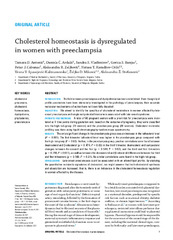Приказ основних података о документу
Cholesterol homeostasis is dysregulated in women with preeclampsia
| dc.creator | Antonić, Tamara | |
| dc.creator | Ardalić, Daniela | |
| dc.creator | Vladimirov, Sandra | |
| dc.creator | Banjac, Gorica | |
| dc.creator | Cabunac, Petar | |
| dc.creator | Zeljković, Aleksandra | |
| dc.creator | Karadžov-Orlić, Natasa | |
| dc.creator | Spasojević-Kalimanovska, Vesna | |
| dc.creator | Miković, Željko | |
| dc.creator | Stefanović, Aleksandra | |
| dc.date.accessioned | 2022-01-18T12:36:14Z | |
| dc.date.available | 2022-01-18T12:36:14Z | |
| dc.date.issued | 2021 | |
| dc.identifier.issn | 0032-3772 | |
| dc.identifier.uri | https://farfar.pharmacy.bg.ac.rs/handle/123456789/4023 | |
| dc.description.abstract | Introduction The link between preeclampsia and dyslipidemia has been established. Even though lipid profile parameters have been intensively investigated in the pathology of preeclampsia, their accurate molecular mechanisms of action have not been fully decoded. Objectives We aimed to identify the specifics of cholesterol metabolism in women affected by late‑onset preeclampsia and single out potential biomarkers associated with late‑onset syndrome. Patient s and methods A total of 90 pregnant women with a priori risk for preeclampsia were monitored at 4 time points during gestation and, based on the outcome of pregnancy, they were classified into the high‑risk group (70 women) and the preeclampsia group (20 women). Cholesterol metabolic profiling was done using liquid chromatography‑tandem mass spectrometry. Result s The only significant change in the preeclampsia group was an increase in the lathosterol level (P = 0.001). The first‑trimester lathosterol level was higher in the preeclampsia group compared with the high‑risk group (P = 0.02). Further, in the preeclampsia group, positive correlations were found between desmosterol and β‑sitosterol (ρ = 0.474; P = 0.03) in the third trimester, desmosterol and campesterol changes between the second and the first (ρ = 0.546; P = 0.02), and the third and first trimesters (ρ = 0.754; P <0.001), as well as between the desmosterol and β‑sitosterol differences between the third and first trimesters (ρ = 0.568; P = 0.01). No similar correlations were found in the high‑risk group. Conclusions Late‑onset preeclampsia could be associated with an altered lipid profile. By studying the quantitative metabolic signatures of cholesterol, we might assume that both cholesterol synthesis and absorption are increased, that is, there is an imbalance in the cholesterol homeostasis regulation in women affected by the disease. | |
| dc.publisher | Medycyna Praktyczna Cholerzyn | |
| dc.relation | info:eu-repo/grantAgreement/MESTD/Basic Research (BR or ON)/175035/RS// | |
| dc.rights | openAccess | |
| dc.rights.uri | https://creativecommons.org/licenses/by-nc-sa/4.0/ | |
| dc.source | Polish Archives of Internal Medicine | |
| dc.subject | Dyslipidemia | |
| dc.subject | Preeclampsia | |
| dc.subject | Cholesterol homeostasis | |
| dc.subject | Cholesterol precursors | |
| dc.subject | Phytosterols | |
| dc.title | Cholesterol homeostasis is dysregulated in women with preeclampsia | |
| dc.type | article | |
| dc.rights.license | BY-NC-SA | |
| dc.citation.volume | 131 | |
| dc.citation.issue | 12 | |
| dc.citation.rank | M21 | |
| dc.identifier.wos | 000738916000019 | |
| dc.identifier.doi | 10.20452/pamw.16144 | |
| dc.identifier.scopus | 2-s2.0-85122539935 | |
| dc.identifier.fulltext | http://farfar.pharmacy.bg.ac.rs/bitstream/id/9379/Cholesterol_homeostasis_is_pub_2021.pdf | |
| dc.type.version | publishedVersion |

